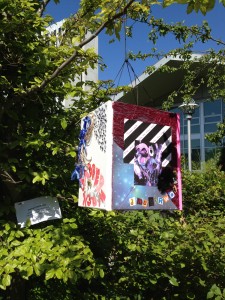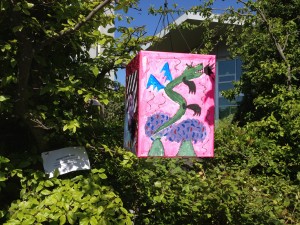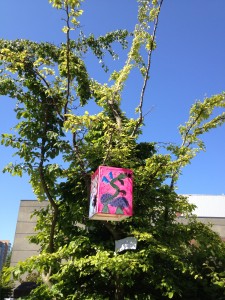Hi everyone,
Here is our write-up for our project in PDF form, as well as the link to our map again.
LLED 368 Media II Project WRITE UP
Link to our map: http://goo.gl/maps/wZyqk
Cheers,
Katrina, Samantha, Zlatina, Dominic
Hi everyone,
Here is our write-up for our project in PDF form, as well as the link to our map again.
LLED 368 Media II Project WRITE UP
Link to our map: http://goo.gl/maps/wZyqk
Cheers,
Katrina, Samantha, Zlatina, Dominic
Hi again everyone!
Here is the upload explaining our group’s second media project presentation (continuation of The Lottery dramatic performance). Hope you’ll find it useful!
– Adam, Irene, Katarina, Natalia and Natasha
For our 2nd project, Fatima, Lisa and I explored some different platforms for digital story-telling. The work we created for this project is here.
Here is our write up for Media Project 2.
Kress argues that the education system today is embedded in a time and place that no longer exists- that it was cemented in a time of stability. He now refers to “a different kind of social subject” (138) to which the educational system doesn’t match. He writes that “the social subject educated […] for an era of social and economic instability is deeply different to the social subject of the preceding era: a citizen/worker/professional who was educated toward the stabilities of well-defined citizenship or equally stable subjectivities as a participant in stable economies” (139). He also claims that “the social mores, cultural values, forms of the economy and the social organizations of 1955 had more affinity with those of 1855 than they have with those of 1995” (133). This gave me pause. The Industrial Revolution, two world wars and massive migration to North America seems rather significant to me. What can compare to these events between 1955 and 1995? Vietnam, Korea, the fall of the Berlin Wall, the break-up of Yugoslavia? These are all significant events, but certainly not as influential as the events previously mentioned between 1855 & 1955. My sense is, and given the context of this course, that it is the advent of the computer and the digital world that helps Kress to make this claim. I agree that since 1955 the world has changes significantly. In an academic context we could understand this as the shift from Modernism to Post-Modernism
The concept of Modernism has its roots in the Industrial Revolution and crystallized during the First World War. Post-Modernism cannot be understood without the foundation of Modernism, but is characterized by a rejection of the tenets of Modernism. It is a disambiguation of what we thought we knew, and what we think we can come to know.
Multiple (digital) literacies are characterized as a shift away from traditional literary texts, ways of knowing and achieving meaning, but we can’t understand these new literacies without traditional based language and literary forms. Multiple literacies embrace a new space-time continuum and reflect a post-modern socio-cultural conundrum. Kress notes the market based economy has transcended a state based allegiance (141), though I’m not convinced the two are that separate. Digital literacies are embedded in a place that is always open, and are upheld by (if not initiated by) business interests and much of it seems to be a deviation from what is meaningful. Digital literacies are characterized in a post-modern era as a cacophony of voices and formats which may actually serve a purpose of consumption rather than idea-making. Much is said and suggested of what the English classroom is for in our post-modern times, and how canonical literature serves an ideal of a world gone by. During my university English classes I always appreciated the simple delivery, the loose adherence to time (course schedule, due dates), the often simple class syllabi which didn’t have any charts, shading, text boxes and the like, and a rejection of the use of power-point or Prezi. Everything was scaled down to its core idea, without the need to be delivered with fancy dressing or false advertising. It was a space for confronting complex ideas and theories in as simply a way as possible. In our multi-modal reality, I think this simple approach is more important than ever.
Are there opportunities in the post-modern high school English class to embrace the concept of multi-literacies? Absolutely. Without question there are some very valid avenues for non-traditional learning, expression and communication, but to me the English teacher ought to attempt to slow the pace down a bit, and nurture the old-fashioned and out of style introvert. Multiple literacies reflect a world that is changing at a rapid pace, but change has always occurred. What is unique to our time is the rapidity of the change. In fact change in this time might be more mediated illusion driven by corporate/state interests, rather than a result of personal agency. What is true is that we are living our lives at a pace that is snowballing out of control, leading us to unprecedented states of anxiety, depression and general unhappiness and dissatisfaction. We need to slow down and enjoy the moment. What better way than to relax in your favourite rocking chair with a good book, canonical or otherwise?
-Adam
Here is the PDF with information regarding our second media project, as well as a link to the video. Enjoy!
LLED 368 (951)_Media Project #2
https://www.youtube.com/watch?v=bbDZwojMJv8
–Christa, Cat & Chris
In his article “Curriculum for the Future” Gunther Kress outlines the reality of current curricular needs. He does this by labelling the curricular needs of the past as a program for ‘stability’, while labelling today’s curricular needs as program for ‘instability’. At first, I was curious what this was all going to allude to. When I thought of past stability I though of the industrial revolution and the shaping of good citizenry. But what about today’s curricular needs of instability? It’s hard to imagine what today’s generation is going through in regards to job niching, myself entering into a well-established and age-old profession. However, Kress educates us preservice teachers on what to teach so that our students will be successful in creating careers for themselves in “tomorrow’s instability”. To summarize the past-present situation, Kress notes:
“Economies founded on services and information do not (necessarily) need
the knowledge of the subjects of the older curriculum. Instead of attitudes and dispositions to ®xed knowledge, both the economy of services and the
economy of information demand the ability to design: to design objects
(whether as texts or as commodity of any kind) and to design processes (whether
in entertainment, in business or in education). The ability to design, an aptitude
in using the resources available for making (whether the making of representations for communication or the making of objects for consumption) differs
fundamentally from the aptitudes and dispositions previously needed, prized
and rewarded.
The ability to design, it seems, is taking over the past need for the ability to recite canonical texts. As a final thought in this course, this is indeed very wise advice. Knowing this, I feel more comfortable assigning creative projects with various media instead of fussing over Shakespeare and Steinbeck. But what of these texts? Is there no longer value in teaching text-based literary analysis? And what about regular literacy? Surely, students still need to be able to articulate themselves with correct syntax and signifiers of the English language—spell check cannot write for you. I guess that this will all be fine balancing act in our practice as teacher. Thinking back to our “Curriculum & Knowledge” course, teachers are indeed the ones who decide what is important for the current generation to know. Perhaps it all goes back to the purpose of schooling and who will be in “charge”, as concluded by Kress:
“I have assumed the continued existence of the school, even if in greatly changed form, but the school will only
retain its place if it, or those who are responsible for it, face the question of the ®t between curriculum and the new shapes of work and leisure around the
school and if the question of wider purposes for each subject in the curriculum
can be satisfactorily answered.”
I guess the answers will come soon, in tomorrow’s instability.
Kress, Gunther. “A curriculum for the future.” Cambridge journal of education30.1 (2000): 133-145.
Hello! Here is the link to our stop motion video:
https://www.youtube.com/watch?v=_c-Ts-370JU
Link to our written component:
As well for anyone wondering, the white board we used was 9×7″ from Staples!
-Mary Zolkiewski and Katherine Spilsted
Description of the Project:
This project is an extension of our first project, the “Jabberwocky” hypertext poem. We decided to create a three-dimensional tetraptych inspired by the poem and our experiences working on its hypertext counterpart. Each of us has created a visual representation of “Jabberwocky” elements. Just as our online version of the poem brought together our individual interpretations of Carroll’s work, our art installation combines each of our visual representations into one large, four-part art piece.

In considering how to display this artistic adaptation to our peers, we discussed with one of our classmates the possibility of incorporating our project into his, which is a QR code “scavenger hunt” of sorts that will take place on UBC campus on the day of presentations. We created a QR code for our project that will take visitors back to the hypertext poem – the first iteration of our adapted “Jabberwocky” – when they scan it. We will have the QR code displayed near the artistic adaptation, and so the two will be able to function in tandem to enhance readers’ and viewers’ knowledge of Carroll’s poem.

Our Design Process:
Once again, we relied primarily on group brainstorming sessions. Our “Jabberwocky” hypertext poem was a completely digital endeavor which focused on opening a dialogue in order to create a collective understanding of a text. With this newest “Jabberwocky project,” we wanted to create something more tangible, so we decided to set aside our computers and create a physical art piece. However, we didn’t want to sacrifice the sense of fluidity that the hypertext poem embodied so well. In order to give our art piece the same sense of a “living text” that the hypertext poem had, we decided to attach the four canvas pieces together so that they form a hanging cube. This way, the piece retains a sense of movement and life reminiscent of the ever-changing hypertext poem. Indeed, our “Jabberwocky” tetraptych somewhat resembles a child’s hanging mobile — although, its rather twisted fairytale content might not be the most comforting visual to hang above a baby’s crib.1. What process did you use to develop your idea? Include any brainstorming prompts and approaches.
In order to present our project, we have placed our Jabberwocky in an outdoor setting. As mentioned before, we created a QR code to accompany our piece. It links to the first part of our project – the hyperlinked poem – so that viewers of the artistic rendering of “Jabberwocky” can easily access the words that inspired it.
2. What other pre-production strategies did you employ? For example, if you completed a video, to what extent did you “storyboard” and how did you develop the script? *Include any templates for storyboarding or other pre-production activities.
As this project was an extension of the first, it could be argued that the entire first project (our hyptertext poem) was a sort of pre-production strategy leading us up to the process of creating this second project. For each of our four canvas pieces, we worked independently and based our creations on our own interpretations of the poem. We knew only that each of us would use a variety of media (paint, crayon, felts, collage materials, natural materials, etc.) to create a visual representation of the Jabberwocky (either the beast itself or the poem as a whole). We had no idea what each of our pieces might look like and only saw them when we met together to put the whole piece together. We made sure that we purchased the same size and style of canvas to ensure that the structure of the piece would be uniform, unlike the styles and materials used on the canvas itself.
Similar to the two groups that presented their stop-motion videos, we encountered unforeseen obstacles in pre-production. For example, one of us (who shall r
emain unnamed) forgot her primary colours while purchasing acrylic paint at the dollar store and eventually realized that it is impossible to make orange paint without yellow paint. After a misguided foray into painting with mustard, it was decided that black fire, rather than orange fire, would be a compelling (and necessary) artistic statement.

3. How did you assign tasks or roles within your group? How did you manage time?
As it is a collaborative art piece, our roles were equal. We each purchased four canvas boards of equal size and set out to fill our blank canvases with our own visual representations of the poem. We each completed our quarter of the piece individually, and then we met together afterwards to put the pieces together. Other than our brainstorming meetings, our work was done individually on our own time. Furthermore, we used Google Docs to keep track of notes and to collaboratively complete all documentation.
4. What approaches would you use to assess this activity that take account of the following: a) the multimedia nature of the assignment; b) the collaborative nature of the assignment. *Include a draft assessment rubric.
Our experience with creating a rubric for the first part of our Jabberwocky project reminded us of the importance of valuing creative work as equal to “academic” work in our classrooms. As we’ve discussed in our class, too often, students who complete creative assignments are also required to give legitimacy to their work through text.
In order to give value to students’ creations for this assignment, we’ve decided to focus primarily on the process and not on the product. We’d ask students to keep a diary of some sort – text, visual, or otherwise – documenting their experience as they worked on their projects. The students would then be asked to present their projects and describe their experience and the results to the class. Finally, they would complete a self-evaluation and answer these questions:
1. Now that you have finished your project, what do you think worked well? Is there anything you would do differently if you were starting again?
2. Does your project accomplish what you intended? Why or why not?
3. Is there anything you think viewers of your creation should know that would help them better understand it?
Students would then give themselves a mark, focusing mostly on the creative process and their documentation of it, but also taking into account what they accomplished with their finished product. The teacher would also come up with a mark, and student and teacher would meet to discuss a final, collaboratively produced grade.
5. What are the greatest challenges in using this approach in a classroom and can they be ameliorated through careful instructional design? What learning opportunities does this activity afford? *Include a formal statement describing your goals in completing this assignment along with the drawbacks and affordances of the approach. All references and materials for this project should be included in a bibliography employing APA or MLA format.
We had difficulty thinking how best to translate the hypertext into a meaningful concrete medium and finally agreed upon the tetraptych as it allows for individual exploration of the poem’s content as well as a comparison across the group of just what the poem inspired in individual readers. Our biggest difficulty came when deciding on how to assess this project as giving a numerical mark for an artistic process can be challenging not only for the student (to self assign a mark), but also for a teacher who makes a value judgement when assigning a mark to a student’s creative work. Finally, we decided that a collaborative mark (one from student, one from teacher) that relies on the students’ ability to speak about the artistic process makes the most sense in evaluating a project that is centred around artistic merit and creativity.
In terms of opportunities – the students are able to begin their work in an online medium and translate it into a concrete form, while also turning their individual initial project (the hyperlinked text) into a group project. This allows students to compare and contrast their interpretations of a poem with their classmates. Often, projects go in the other direction (from concrete to online), so we thought it might be interesting to allow students to experiment with the reverse process (beginning with online and moving through to a concrete art representation).
Our goals for this assignment were to have students work through an artistic process of mounting a poem in a physical form; also, we aimed to have students use their online rendition of the poem and translate it into a physical form. Finally, we want students to be aware of the processes involved in creating thoughtful art, hence the questions asking students to self-reflect on the process of the project.
Thanks!
– Allison, Ilana, Ashlee, and Shannon
Hello!
Thank you for taking part in our activity today. We had fun. Sorry about the casualties…
Here is the pdf file for our project.
Enjoy!
-Andrew Knorr, Stephanie Moreno, Jacqueline Simpson
More information on the making of our stop motion video, sUPer suffix
A link to the video…if you want to watch it again.
And…here are some photos of our filming process, including the awesome water bottle tripod!